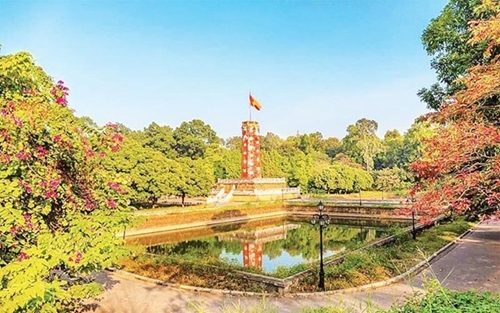The site marks its 200 years of existence this year, with an official celebration slated for November 12 in a bid to raise the public awareness on heritage protection and preservation and stimulate tourism demand.
    |
 |
|
The flag tower inside the citadel |
According to historical documents, Son Tay Citadel was built in 1822 during the reign of Minh Mang Emperor (1791-1841) under the Nguyen Dynasty. It was built entirely of laterite, a material that meets the requirements of a defensive building and was available in the locality.
Following the style of France's Vauban architecture, each side of the square citadel was about 400m long and 5m high. The citadel had four gates facing east, west, south and north, called the Front (Tien), the Back (Hau), the Right (Huu) and the Left (Ta). Each entrance had a guard tower.
Many great events related to the Nguyen’s fighting against French colonialism in Vietnamese history took place in the citadel, reflecting its critical significance in guarding the northern plains and midlands and backing the Northwest border.
After nearly 200 years and with much devastation, only a few relics are left, including an octagonal 18-meter-high flag tower, some stretches of the citadel walls, the citadel gates, guard towers, Kinh Thien's Palace platform, two cannons and some ruins at Vong Lau, the foundation of Kinh Thien palace and the wells.
Due to its important cultural, historical and unique construction techniques, the Governor General of Indochina granted it with relic statues in 1924. It was later recognized as a national historical relic by the Ministry of Culture and Information (now the Ministry of Culture, Sports and Tourism) in 1994.
Carrying out research on Son Tay Citadel for many years, President of the Vietnam Archaeological Association Tong Trung Tin said that the site represents a period when ramparts were built the most in Vietnam, given the context of colonization taking place all over the world. Experiencing many ups and downs, Son Tay Citadel still retains the best vestiges, demonstrating the construction techniques of defensive military works in the North. Meanwhile, most of the other citadels have basically lost all of their traces.
Echoing the view on the site’s value, Nguyen Huy Khanh, former Vice Chairman of Son Tay town People's Committee, said the conservation of the citadel has received significant investment from the State and the support of the local people over the past time.
Currently, a pedestrian walking area has been formed around the fortress, the fourth of its kind in the capital city. The space attracts about 25,000-30,000 visitors at weekends after its launch in April 2022.
The old citadel today impresses visitors with its serenity and calm. Ancient trees give it shade all year round; lotus ponds, and green grass create a picturesque site.
Nguyen Thi Toan, a 70 years old resident in Son Tay town’s Phu Thinh ward, said that on weekends, the citadel is crowded with tourists. Locals’ income and living standards have been improved thanks to business activities from tourism, she added.
Secretary of the Son Tay Party Committee Tran Anh Tuan said the locality is implementing various measures to promote the heritage, including the compiling of a dossier for it to be recognized as a special national relic site.
Vice Chairman of the Son Tay People’s Committee Le Dai Thang said a series of enticing cultural, tourism and sport events are scheduled for the marking of the site’s 200th anniversary. Highlights among them are a photo exhibition and a hot air balloon festival.
Source: VNA